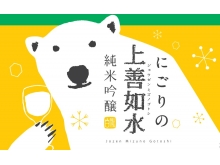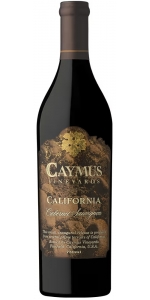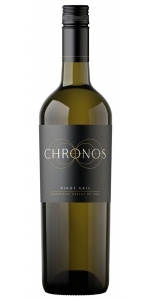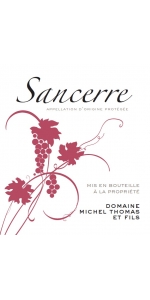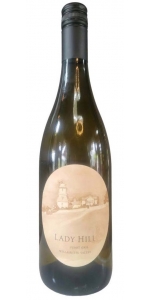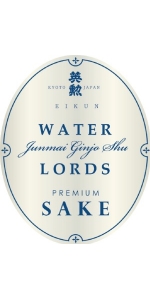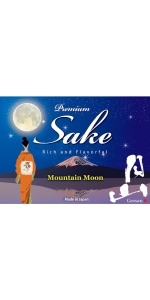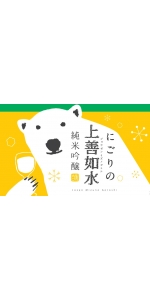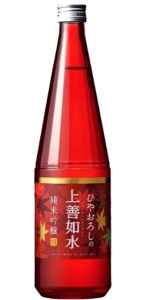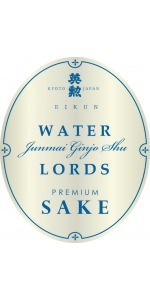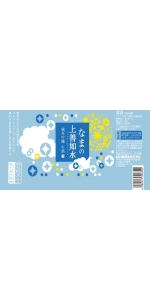Jozen Mizuno Gotoshi Junmai Ginjo Nigori (300ml)
12 bottles with free shipping for: $264.00
| BUY MORE! SAVE MORE! | ||||||||||||||||
|
| Country: | Japan |
| Winery: | Shirataki Shuzo |
| Grape Type: | Rice Wine (Sake) |
| Organic: | Yes |
| Vintage: | NV |
| Bottle Size: | 300 ml |
Inviting aromas of mint, marshmallow and Asian pear pull you into this drink. Surprisingly dry, this Nigori (cloudy) style sake has a rich, chewy texture. The intriguing mid palate features mint, white chocolate, and tart cherries. The finish belies our expectations with an elegant, softness of minerals that settles in a dry finish.
Pair with roast duck, dry-rub ribs, full flavored country pate, and fruit and nut desserts of light sweetness.
Mildly ripe Coulommiers or Brie, Italian Raschera.
ABOUT SHIRATAKI SHUZO:
Shirataki is located in the heart of the Japanese Alps called "Snow Country" in the Niigata prefecture. Each spring the snowpack melts providing an abundance of clear natural spring water. This water runs through a coal seam providing a natural filtration process that accentuates the taste and quality of the water. This very soft water is the secret behind the very light, elegant, pretty style of sake made at Shirataki. The town of Echigo Yuzawa is home to "Koshihikari" a famous high quality rice brand in Japan.
I feel this wine expresses the greatness of California and its hidden pockets where Cabernet can excel. The cold Pacific Ocean running the entire length of the state presents maritime influences – and with each small distance eastward the climate warms. Stony soils, south facing slopes and moderately warm conditions are the keys to producing dark, rich and good tasting Cabernet.
A small release from Caymus Vineyards, this wine is a California-appellation Cabernet Sauvignon – supple, dark and rich, bearing the signature hallmarks of Caymus. It is sourced from sites throughout the state which feature climatic conditions, soils and topography that are ideally suited to Cabernet. This project stems from excitement over California's diverse vineyard land, often in lesser-known areas, with the potential to produce exceptional Cabernet.
Under the stewardship of winemaker Lynzee Schatz, Chronos wines are crafted for lovers of the Okanagan Valley terroir. World class quality with depth, complexity, and command of detail. The production of Chronos is precise and unrushed with a connection to the finest winemaking traditions around the world. Raise a glass of Chronos to inspire your most delightful and soul-stirring moments.
Produced from Dragon Mountain Vineyard, the wine is named after the Ogopogo -mythical lake monster. Grown overlooking Okanagan Lake.
The wine opens with notes of Granny Smith apple and stone minerality, followed by citrus and melon. On the Palate, it shows expressive flavors of pear, peach blossom, melon and lemon with a wonderfully long finish.
Thomas Sancerre Rose is made from 100% Pinot Noir.
Vines are 20-55 years old.
Terroir (soil type) is a blend of "Caillottes" and "Terre Blanche".
Everything is machine harvested (which means it is 100% destemmed).
50% Direct press + 50% Saignée (bled) with 12-24 hours of skin contact maceration.
The alcoholic fermentation is done in temperature controlled stainless steel tanks.
Right before bottling, the wine is fined with Bentonite (very light filtration with oenologic clay).
Tasting Notes:
Light, bright pink. Redcurrant, strawberry and chalk on the nose, with a touch of singed orange gaining strength with air. Dusty red fruit and citrus flavors are braced by tangy minerality, which adds lift and cut. Uncompromising in the best way, finishing with excellent clarity and echoes of lemon and orange zest.
Food pairings:
This is a very versatile wine. You can have it on its own in the summer time as an apéritif. But it is also excellent with Hors d'Oeuvres and terrines. It will compliment any white meat dish and poultry. You can also enjoy it with salmon or exotic food (slightly spicy sushi).
Lady Hill Pinot Gris Willamette Valley is made from 100% Pinot Gris.
An aromatic procession of passionfruit and Meyer lemon embraces the delicate floral side of honeysuckle and white flowers. Bright flavors of citrus rind and white peach are highlighted with a crisp minerality. The mouthfeel indicates almost no malolactic conversion, showcasing the crisp refreshing acidity of Granny Smith apples.
Finn Hill Vineyard and Bellevue Cross sit on opposite sides of the Yamhill-Carlton and McMinnville AVAs, but offer a very similar profile of bright citrus and a grassy herbaceousness. Delicately pressed into a stainless steel tank, the juice was inoculated with a commercial yeast bred to enhance fruity and floral aromatic esters. 2 neutral French oak barrels from Bellevue Cross were blended into the remaining stainless portion to balance any tight acidity the wine was showing.
Pair with sushi, goat cheese, and every salad imaginable from a classic Greek horiatiki to its grainy cousin tabbouleh.
Sake Eikun Junmai Ginjo Water Lords is made with Iwai rice.
Eikun sake uses water from a source called "Fusui", rated as one of the top 100 sources of water in Japan. This water source is located just south of the ancient Japanese, and still cultural capital of Japan, Kyoto.
Aromas of macadamia oatmeal cookie, spicy zucchini bread, and vanilla cream with a satiny fruity-yet-dry medium-to-full body and a layered, banana custard, jicama, salted whole nut, apple, and radish nuanced finish. A Wonderfully vibrant and flavorful sake.-Beverage Tasting Institute 94 points (Exceptional)
RATING: 94 points (Exceptional)
CATEGORY: Junmai Ginjo Sake, Sake
ALCOHOL BY VOLUME: 15.3%
TASTING LOCATION: In Our Chicago Tasting Room
TASTING DATE: Dec-05-2012
WINE ID: 200768
Woodsy honeycomb, nutshell, and mushroom patch aromas with a satiny fruity-yet-dry medium-to-full body and a delicate savory mushroom stock, chestnut, and golden beet driven finish. A fine choice for tempura. 91 Points -Beverage Tasting Institute
RATING: 91 points (Exceptional)
CATEGORY: Junmai Ginjo Sake, Sake
ALCOHOL BY VOLUME: 15.4%
TASTING LOCATION: In Our Chicago Tasting Room
TASTING DATE: Dec-05-2012
WINE ID: 200767
Inviting aromas of mint, marshmallow and Asian pear pull you into this drink. Surprisingly dry, this Nigori (cloudy) style sake has a rich, chewy texture. The intriguing mid palate features mint, white chocolate, and tart cherries. The finish belies our expectations with an elegant, softness of minerals that settles in a dry finish.
Pair with roast duck, dry-rub ribs, full flavored country pate, and fruit and nut desserts of light sweetness.
Mildly ripe Coulommiers or Brie, Italian Raschera.
Hiyaoroshi is a general term referring to sake that has been pasteurized once in the winter and then allowed to mature over the summer before distribution in autumn. The Japan Sake Brewers Association designates September 9th as the official start for Hiyaoroshi sales. (Essentially aged Namazume)
September 9th is known as Kiku-no-Sekku (“Chrysanthemum Festival”), where hundreds of chrysanthemums are displayed around various venues and chrysanthemum sake is served. The chrysanthemum (kiku) was brought to Japan from China during the Nara period. In 1183, it was adopted as the Imperial Seal of Japan, and during the Meiji period no one but the Emperor could use it. Nowadays it still represents the authority of the emperor and you can see it everywhere in Japan.
Aromas are forward, fresh, and fruity in the nose with notes of sweet melon, cherries, and hints of vanilla. Flavors on the palate evoke feelings of the season with pumpkin pie, roasted nuts, and stewed plums. This sake is medium-bodied and accented by medium acidity, showing classic Jozen minerality and a lingering dry finish. Additional 7 months of aging adds depth and roundness.
{Pairs with roasted poultry, baked ham, butternut squash ravioli, BBQ, and dishes with sweet spice.
Aged Gouda, triple cream, fresh chevre .
Hiyaoroshi is a general term referring to sake that has been pasteurized once in the winter and then allowed to mature over the summer before distribution in autumn. The Japan Sake Brewers Association designates September 9th as the official start for Hiyaoroshi sales. (Essentially aged Namazume)
September 9th is known as Kiku-no-Sekku (“Chrysanthemum Festival”), where hundreds of chrysanthemums are displayed around various venues and chrysanthemum sake is served. The chrysanthemum (kiku) was brought to Japan from China during the Nara period. In 1183, it was adopted as the Imperial Seal of Japan, and during the Meiji period no one but the Emperor could use it. Nowadays it still represents the authority of the emperor and you can see it everywhere in Japan.
Aromas are forward, fresh, and fruity in the nose with notes of sweet melon, cherries, and hints of vanilla. Flavors on the palate evoke feelings of the season with pumpkin pie, roasted nuts, and stewed plums. This sake is medium-bodied and accented by medium acidity, showing classic Jozen minerality and a lingering dry finish. Additional 7 months of aging adds depth and roundness.
{Pairs with roasted poultry, baked ham, butternut squash ravioli, BBQ, and dishes with sweet spice.
Aged Gouda, triple cream, fresh chevre .
Sake Eikun Junmai Ginjo Water Lords 12/720ml is made with Iwai rice.
Eikun sake uses water from a source called "Fusui", rated as one of the top 100 sources of water in Japan. This water source is located just south of the ancient Japanese, and still cultural capital of Japan, Kyoto.
Aromas of macadamia oatmeal cookie, spicy zucchini bread, and vanilla cream with a satiny fruity-yet-dry medium-to-full body and a layered, banana custard, jicama, salted whole nut, apple, and radish nuanced finish. A Wonderfully vibrant and flavorful sake.-Beverage Tasting Institute 94 points (Exceptional)
RATING: 94 points (Exceptional)
CATEGORY: Junmai Ginjo Sake, Sake
ALCOHOL BY VOLUME: 15.3%
TASTING LOCATION: In Our Chicago Tasting Room
TASTING DATE: Dec-05-2012
WINE ID: 200768
Made with Iwai rice.
Eikun sake uses water from a source called "Fusui", rated as one of the top 100 sources of water in Japan. This water source is located just south of the ancient Japanese, and still cultural capital of Japan, Kyoto.
Rice milling: 60%
Woodsy honeycomb, nutshell, and mushroom patch aromas with a satiny fruity-yet-dry medium-to-full body and a delicate savory mushroom stock, chestnut, and golden beet driven finish. A fine choice for tempura. 91 Points -Beverage Tasting Institute
RATING: 91 points (Exceptional)
CATEGORY: Junmai Ginjo Sake, Sake
ALCOHOL BY VOLUME: 15.4%
TASTING LOCATION: In Our Chicago Tasting Room
TASTING DATE: Dec-05-2012
WINE ID: 200767
This unpasteurized sake is exciting and lively with a nose full of citrus, apple blossom and shizo. The palate is equally as bold featuring fresh persimmons, marshmallow and slightly underipe stone fruit. The finish is clean showing soft minerality.
POLISHING RATIO: 60%
ALCOHOL: 15.5
SMV +/-: +5.0
ACIDITY: 1.6
RICE KOJI: GOHYAKUMANGOKU
RICE KAKE: KOSHI IBUKI
YEAST STRAIN: K1801
FOOD PAIRINGS: Sushi Nigiri with fatty fish, oysters, omelettes, Lighter Italian, Chinese or French dishes
CHEESE PAIRINGS: Mildly ripe Coulommiers or Brie, Italian Raschera
- back
Luis XIV Fondillon Oro 50 years NV is made from 100 percent 100% Monastrell (Mourvedre). Only 24 9 liter cases produced.
The wine is produced in the village of Cañada, in the subarea of Alto Vinalopó in the province of Alicante. Made from 100% Monastrell planted on traditional dry land as bush vines, at 550-580 meters above sea leval and enjoying a Mediterranean climate with great marine influence due to the easterly winds.
Fondillon 50 years is mahogany in color with orange tile rim, medium layer and great density. On the nose, it has a very deep aroma of old wood, black tea and carob. In the mouth, it has a sweet entry balanced by a rich high acidity. Its aromas are long, almost eternal and very intense. It tastes like old mahogany, a very old barrel and bygone times.
Bottled in December 2019.
AGEING:
CASK NAME: Saboners.
AGEING: Aged more than 50 years (single barrel).
TYPE OF WOOD: 19th-century American oak barrels
CASK SIZE: 70 “cántaros valencianos” (805 litros).
ANALYSIS:
GLUCOSE AND FRUCTOSE: 34 gr/litre.
VOLATILE ACIDITY: 1.35 gr/l.
ALCOHOL: 16.2º (NO ADDED ALCOHOL).
FREE SULFITES: less than 10 mg/litre.
TOTAL SULFITES: 76 mg/litre.
Review:
Dark mahogany color, candied fruit aromas, fruit liqueur notes, spicy, varnish, acetaldehyde, bakery, complex. Fine solera notes, bitter flavors."
- Penin 2022, 99 pts
"The NV Fondillón Luis XIV has the subtitle Edad Superior a 50 años (over 50 years old), and it's a dark mahogany, bottled from a single barrel that has the specific profile of a very old wine greatly concentrated by age, which tends to make it similar to other very old and concentrated wines, be it a Mediterranean rancio or a very old Moscatel. It has notes of bitter chocolate, coconut and iodine, carob beans (algarroba) and some bittersweet sensations. It's dense and concentrated, and the palate is pungent, with very intense flavors and a bitter twist in the finish. This has 16.3% alcohol, 6.45 grams of acidity and 34 grams of sugar, but it comes through as very dry. The wine is long and extraordinary, but it just doesn't have any Fondillón character after decades of concentration by evaporation. The price is ludicrous. Only 435 half-liter bottles were filled in December 2019. - Luis GUTIERREZ
- Wine Advocate (September 2020), 95 pts
"Fondillón is an extraordinary treasure of Alicante, a rare product, made from late harvest, non-botrytised grapes, unfortified, but with a final alcohol of no less than 16%. Intense, aged, but not sweet (deliciously not more than 45g/l). Fab with cheese or dark chocolate. The wines have to be a minimum of 10 years; this release is more than 25 years. The project is a revival by David Carbonell of Vins del Comtat and two local families. Very limited quantities. - Sarah Jane Evans MW"
- Decanter (December 2021, My top 10 Spanish fine wines of 2021), 95 pts
Cap Cette Picpoul de Pinet is made from 100 percent Picpoul de Pinet
A very popular, traditional local variety planted on sun-drenched hillsides called "costières" (coastal region) in the Mediterranean garrigue, near the Etang de Thau - a coastal lagoon situated between the port of Sète and Marseillan.
The color is a superb pale yellow with bright hues. The nose is elegant, with aromas of fresh fruit and citrus fruit especially grapefruit. Well-balanced with typical focusing and zesty acidity. A pure expression of the grape varietal, the wine shows how good Picpoul can be when grown on its favorite terroir.
It will complement a vast array of dishes such as Asian cuisine, sushi, spicy fare and all sorts of seafood and grilled fish. Enjoy!

